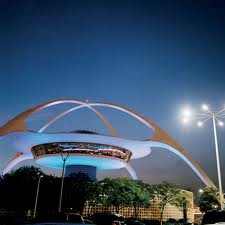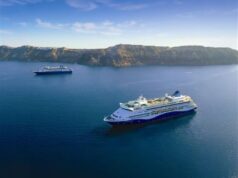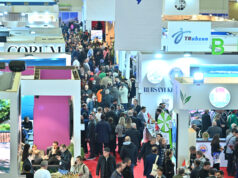 Award-winning Design Creates New Architectural Icon For Los Angeles; Integrated Environmental Media Systems – A First at A U.S. Airport – Synchronizes Multi-Media Content to Interact With and Entertain Passengers; Customs and Border Protection Federal Inspection Area Expanded and Upgraded
Award-winning Design Creates New Architectural Icon For Los Angeles; Integrated Environmental Media Systems – A First at A U.S. Airport – Synchronizes Multi-Media Content to Interact With and Entertain Passengers; Customs and Border Protection Federal Inspection Area Expanded and Upgraded
Los Angeles Mayor Eric Garcetti was joined today by former mayors and elected officials; airport officials and representatives of airlines; and other airport tenants to commemorate the start of flight operations in the South Concourse of the New Tom Bradley International Terminal (TBIT) at Los Angeles International Airport (LAX). The start of operations marks completion of Phase I of the overall $1.9-billion New TBIT Project.
The New Tom Bradley International Terminal is considered the crown jewel of the $4.1-billion LAX Capital Improvements Program-Phase 1, the largest public works project in the history of the City of Los Angeles. The New TBIT Project is creating nearly 4,000 construction-related jobs during the project’s five-year schedule and nearly 2,000 permanent concession jobs with the start of operations.
Shortly after 12 a.m. this morning, the 30 foreign air carriers at TBIT began transitioning operations from aircraft gates in the existing Tom Bradley terminal, to five new gates on the west side of the new terminal’s South Concourse. In addition to three gates in the North Concourse that opened in March 2013, there are now a total of eight new gates on the west side of the terminal, all of which can accommodate larger, new-generation (Group 6) aircraft such as the Airbus A380 super jumbo jet and Boeing 747-8 Intercontinental. Arriving international passengers also began processing through an expanded and upgraded U.S. Customs and Border Protection federal inspection area.
Passengers will also experience for the first time, a significant feature of the New TBIT, one of the most advanced multimedia Integrated Environmental Media Systems (IEMS) at a North American airport. Designed to create an unprecedented passenger experience and a non-aeronautical revenue source for LAX, the revenue-generating platform is considered the first sponsorship program at a U.S. airport. The IEMS includes seven very large media features built within the new terminal’s interior architecture. Comprised of over 12,000 square feet of light-emitting-diode (LED) tiles, hundreds of liquid-crystal-display (LCD) screens, a dedicated control and content management network system, and some 60 ultra-high-resolution multimedia productions totaling more than four hours of original content, the IEMS sets a new global standard for airport media systems.
The 150,000-square-foot Antonio Villaraigosa Pavilion will soon impress passengers from around the world with more than 60 premier dining and luxury retail and duty-free shops – including 22 local L.A. brands – and other world-class amenities. The new dining and retail collection will phase-in as concessions transition from pre-security to post-security. The existing concessions will remain open as new and exciting dining and shops are opened progressively in the coming days and weeks.
New TBIT’s initial $1.5-billion cost remains on budget for construction, public art, architectural and engineering designs, permits, and other “soft” costs for the terminal facility itself. Since the original design was completed, several individual projects estimated at a total of $400 million and budgeted separately under the overall LAX Capital Improvements Program-Phase 1, have been shifted from other project budgets, and integrated into the New TBIT Project budget to ensure timely completion of the overall project. These include: the IEMS, additional airline club lounge space, increased food-and-beverage concession areas, demolition of the existing north and south boarding gate concourses, and rebuilding the aircraft parking aprons (tarmac) and two taxilanes. Total budget for the New TBIT Project is now $1.9 billion. The LAX Capital improvements Program remains at the original $4.1-billion budget. With the additional scope items, overall New TBIT Project is expected to be completed in 2015.
The New TBIT Project cost is funded from LAX’s operating revenues, capital improvement program funds, fees from airlines, passenger facility charges, and airport revenue bond proceeds. NO monies from the City’s general fund are being used.
The new terminal is expected to help LAX retain its competitiveness as the premier U.S. West Coast international gateway, especially to the fast-growing Asia-Pacific region.
“The Tom Bradley International Terminal at LAX is the first and last impression of Los Angeles for nine million travelers every year,” said Mayor Garcetti. “This new terminal enhances passenger safety and security, while giving travelers the first-class airport experience they expect from a world-class city like Los Angeles. On a local level, this project creates 4,000 construction-related and 2,000 new permanent jobs for Angelenos, helps grow tourism in our city, and provides a critical boost to our economy.”
“Tourism and international travel is playing an ever larger role in our local economy, and it continues to be very competitive,” said Los Angeles City Council President Herb Wesson, Jr. “The Tom Bradley International Terminal at LAX is the engine that drives and facilitates much of that economy, and Los Angeles must be able to compete. This important investment in our tourism infrastructure at LAX will reap rewards for our city for many years to come.”
“With this grand opening, Los Angeles now has an international terminal that embodies everything that is great about our city,” said Los Angeles City Councilmember Mike Bonin of District 11, which includes LAX “With first-of-its-kind technology, shops and restaurants that showcase LA brands and a vastly improved passenger experience, the new Tom Bradley International Terminal is welcoming, efficient and forward-looking. It’s a big step towards making LAX a world-class airport, and a monument to the great things that we can accomplish by working together.”
“Los Angeles International Airport is our gateway to the world, and the new terminal showcases what’s best about our city,” said Los Angeles City Councilmember Tom LaBonge of District 4 and chairman of the Council’s Trade Commerce and Tourism Committee. “I’m excited to welcome the world’s visitors into the newest room of our house.”
Los Angeles Board of Airport Commissioners President Sean Burton said, “LAX is the U.S. West Coast’s premier international gateway – especially to Asia-Pacific, the fastest growing commercial aviation region in the world. The new terminal will improve passenger comfort, convenience and safety, and will help LAX retain its global competitiveness.”
Los Angeles World Airports Executive Director Gina Marie Lindsey said, “Passenger-friendly terminals and conveniences, airplane-friendly taxiways and gates are all ‘must haves’ as airports
around the world compete for the economic vitality that world-class airports create. Our goal is to modernize LAX to ensure it retains its vital role as the cornerstone of Southern California’s air transportation system.”
New Iconic Architecture
The intent of Fentress Architects’ design of the New TBIT is inspired by the Pacific Ocean on LAX’s west side, with a flowing roofline that recalls the rhythm of waves breaking on the beach. An open and spacious 110-foot-tall Great Hall suffused with natural daylight acknowledges Southern California’s temperate climate, while its aluminum roof arches over the column-free
structure. This creates a single, cohesive, architectural theme that unifies the entire terminal, inside
and out. The new terminal has already won architectural design awards and is expected to become a new iconic structure for Los Angeles, joining the historical LAX Theme Building and its parabolic arches.
“What makes the architecture in the New Tom Bradley International Terminal so significant is that it represents the majestic quality and contemporary philosophies of Los Angeles. Its inspired design solution is in response to its setting, the beautiful waves of the Pacific Ocean,” said Curtis Fentress, principal in charge of design for the LAX modernization.
Enhanced Aesthetics
An Integrated Environmental Media System (IEMS) is an aspect of the new terminal that focuses on enhancing the passenger experience. The IEMS Project — directed by MRA International and designed by Sardi Design — is comprised of seven iconic, architecturally-scaled media features built within the new terminal’s architecture and designed to enhance a particular aspect of the passenger departure or arrival experience. Carefully-curated multimedia content produced by Moment Factory and brand content produced by Digital Kitchen celebrate the joy and romance of travel and highlights Los Angeles’ unique personality as a world-leading creative hub. It is the first media system to synchronize multiple features through a state-of-the-art, content-management system that creates an integrated environmental experience based on intelligence from live data, including flight departure and arrival information, and passenger interactions. Airport officials expect to later program the IEMS to also serve as a source of non-aeronautical revenues through corporate sponsorships. The content management system was designed by Smart Monkeys Inc., and Electrosonic Inc. performed systems engineering and integration.
One of the features, the 72-foot-tall Time Tower, is considered the world’s largest with an interactive base that triggers content across 5,480 square feet of LED surfaces. The IEMS has a total output of more than 105 million pixels (eight times an IMAX theater) — which is 19,075 square feet of video – and has 88 high-definition (HD) video playback channels, enough to run all the media screens in New York City’s Time Square district.
World-Class Dining and Retail Showcase Local Favorites and Global Designer Brands
Terminal concessions manager Westfield and its partners are investing $79.8-million to deliver a world-class traveler experience at the New TBIT. Featuring 360-degree views, inviting storefronts and sustainable elements, the dining and retail design criteria by Westfield will soon provide travelers with unique areas to explore as they journey to their destinations. With 31 exciting new options – three times more than before – ranging from luxury dining to healthy-and-fresh sit-down to grab-and-go, Westfield’s dining collections will showcase freshness, demonstration cooking, and sophisticated architecture, and celebrates local restaurants with culinary delights from renowned Top Chefs Michael Voltaggio, duo Susan Feniger and Mary Sue Milliken, Suzanne Goin, and others whose cuisine reflect Los Angeles’ culture, diversity and trends.
“We are pleased to welcome the first travelers into the Villaraigosa Pavilion today to delight in this next-generation airport experience,” said Peter S. Lowy, co-chief executive officer of the Westfield Group. “With flight operations now underway, we look forward to introducing passengers to the best local and global brands as we begin the transition to transform LAX into a global gateway beyond travelers’ wildest dreams, and we look forward to the future of LAX.”
Blending many of the world’s best known luxury designer brands with a distinctly Los Angeles flavor, Westfield’s retail collection, joined by a $25-million investment in the duty-free program by DFS Group, will provide travelers with an array of shopping choices in news-and-gifts, specialty retail, and duty-free shopping, including shops from local institutions such as Fred Segal and Kitson.
“The opening of the New Tom Bradley International Terminal marks an important milestone in the elevation of LAX to its rightful status as a world-class airport,” said Polly Nelson, managing director of DFS North America. “DFS would like to congratulate the City of Los Angeles and particularly Gina Marie Lindsey and her team at Los Angeles World Airports on the opening of this incredible new facility. Through its presence in the new complex, DFS is very pleased to play its part in this transition and is committed to providing a duty-free customer shopping experience that will place LAX among the world’s favorite airports for international travelers.”
The enhanced passenger experience also includes three iconic, permanent public artworks to be installed later this year and in 2014, in keeping with the City of Los Angeles’ Public
Percent-for-Art Program, whereby one percent of construction costs is designated for public art. Three local artists/artist teams have been commissioned: Ball-Nogues Studio is creating a hovering, 7,000-pound sculpture titled Air Garden to be located in the north light well; Pae White
Studio is creating a suspended tapestry titled Woven Walk for the north and south sterile international arrival corridors leading to federal customs and immigration screening; and Mark Bradford is creating a sculpture titled Bell Tower to be suspended above a newly relocated federal passenger security screening area on the mezzanine level of the terminal.
A significant improvement to the “curbside appeal” of the terminal’s upper and lower level entries also has been completed to coincide with the opening of the new terminal. Phase 1 of the New Face of LAX Central Terminal Area Project replaced planters with a colorful light band and new signage more clearly indicating the terminal’s name. Street lamp poles were replaced with new retro-designed poles with brighter, energy-efficient, light-emitting-diode (LED) lights.
Traveler Benefits
Passengers in the new terminal will experience a first-class level of comfort and convenience with:
· 18 new aircraft boarding gates, of which half can accommodate larger, new-generation
(Group 6) aircraft, such as the Airbus 380 and Boeing 747-8
· Roomier boarding gate/waiting areas with half of the seats integrated with electrical outlets for charging personal electronic devices
· Triple (for A380s) and dual passenger-loading bridges for faster boarding and deplaning
· Antonio Villaraigosa Pavilion (Great Hall) with 150,000 square feet of premier dining, retail shopping, airline lounges, a children’s play area, spa, and other passenger amenities
· Public art commissions and Integrated Environmental Media System consisting of seven
iconic state-of-the-art features
· Fully modernized facility will be able to accommodate 4,500 passengers per hour, up from
current 2,800 passengers
Economic Benefits
The New TBIT Project is creating nearly 4,000 construction-related jobs during the project’s
five-year schedule, and nearly 2,000 permanent new concession jobs with the opening of the terminal. An estimated 90 percent of the construction workforce comes from Southern California, and 40 percent of the workers are residents of the City of Los Angeles and other communities near LAX.
Project Scope
Phase 1 of the New TBIT Project, which broke ground in February 2010, includes north and south concourses with nine boarding gates on the west side of the terminal that can accommodate larger, new-generation (Group 6) aircraft, such as the Airbus 380 super jumbo jet and the Boeing 747-8 Intercontinental. The Antonio Villaraigosa Pavilion (Great Hall) features 150,000 square feet
for soon-to-open, casual dining and full-service restaurants; news-and-gift, specialty retail and duty-free shopping options; airline lounges and other passenger amenities. The project adds nearly 1.2 million square feet to double the size of the existing terminal. Over 15,500 tons of structural steel was used during construction – enough to build an 80-story building.
Phase 2 of the project, which begins later this year, includes: demolition of the existing terminal’s east side gates; new boarding bridges and aircraft aprons on the east side of the new terminal; upgraded federal customs and immigration inspection areas; relocation of and upgrade to the federal passenger security screening area; public art installations; and secured corridors between Terminal 3, TBIT and Terminal 4 so connecting passengers can conveniently go from one terminal to the next.
Environmental Sustainability
The project addresses Los Angeles World Airports’ goal for a “greener” LAX. In accordance with LAWA’s Sustainable Design and Construction Guidelines released in 2007, the New TBIT Project optimizes the use of recycled building materials, minimizes the amount of energy used during construction, and optimized energy efficiency. The architecture and construction of the new facilities are designed to achieve a LEED (Leadership in Energy and Environmental Design) Silver certification from the U.S. Green Building Council.
In addition, as part of the program’s environmental requirements and the project-level Environmental Impact Report prepared in accordance with Los Angeles City and California state regulations and in consultation with community stakeholders, the construction project incorporates
practices developed to minimize adverse environmental impacts on the surrounding areas, including, but not limited to: designating specific routes construction vehicles must use when traveling to/from the site; recycling or salvaging more than 75 percent of construction and demolition waste; placing concrete mixers and other equipment on-site to reduce the number of trips made by construction vehicles; retrofitting construction equipment with emission- and noise-reduction devices; installing efficient lighting fixtures and controls with occupancy sensors throughout the terminal to reduce lighting costs and save energy during off-peak hours; installing heating, ventilation and air-conditioning controls that reset temperatures to maximum efficiency without sacrificing occupant comfort; using interior finishes with materials made of recycled content; installing low-flow plumbing fixtures in restrooms; and controlling dust. Of note, permanent left-turn and right-term lanes at two intersections of Imperial Highway adjacent to LAX were constructed to mitigate the impact of construction-related traffic.
Construction Team
LAWA Deputy Executive Director for Airports Development Group Roger Johnson and New TBIT Project Manager Mike Doucette are leading and managing the design and construction of the new terminal. Construction is being performed by Walsh Austin Joint Venture, Los Angeles, which is comprised of Walsh Construction Company and Austin Commercial.
Walsh Austin Joint Venture Project Principal Vincent Piscopo said, “The construction of this truly iconic structure for the City of Los Angeles is exciting, and we take pride in delivering it.”
About Los Angeles International Airport
The more than 30 airlines at Tom Bradley International Terminal served 8.6 million international travelers in 2012, or 50 percent of LAX’s overall 17 million international passenger
volume. LAX is the sixth busiest airport in the world and third in the United States, offering 680 daily flights to 96 domestic cities and 930 weekly nonstop flights to 59 cities in 30 countries on 63 commercial air carriers. It ranks 14th in the world and fifth in the U.S. in air cargo tonnage processed. In 2012, LAX served nearly 63.7 million passengers, processed over 1.9 million tons of air cargo valued at over $86.9 billion, and handled 605,480 aircraft operations (landings and takeoffs). An economic impact study in 2011 reported that operations at LAX generated 294,400 jobs in Los Angeles County with labor income of $13.6 billion and economic output of more than $39.7 billion. This activity added $2.5 billion to local and state revenues. LAX is part of a system of three Southern California airports – along with LA/Ontario International and Van Nuys general aviation – that are owned and operated by Los Angeles World Airports, a proprietary department of the City of Los Angeles that receives no funding from the City’s general fund.
For more information about LAX, please visit www.lawa.aero/lax or follow us on Twitter @LAX_Official, on Facebook at www.facebook.com/LAInternationalAirport, and on YouTube at www.YouTube.com/laxairport1.
Project Partner Media Contacts
https://exftp.lawa.org – Click on “Continue to this website,” then enter user name “New TBIT2013” and password “LAXPR123” (case sensitive)
Los Angeles World Airports (LAWA) ● Fentress Architects
Nancy Suey Castles Katie Dabbs
(424) 646-5260 (303) 282-6192 office
ncastles@lawa.org (720) 206-7710 mobile
dabbs@fentressarchitects.com
New LAX Terminal Flight Operations – Page 7 of 7
● Office of Mayor Eric Garcetti
Jeff Millman ● DFS
(213) 978-0741 Evan Lewis
Jeff.millman@lacity.org (852) 64696111 mobile (Hong Kong)
(852) 27325466 office (Hong Kong)
Westfield Evan.Lewis@dfs.com
Joshua Robbins or Angela Heuer
(323) 813-1529 ● LA Tourism & Convention Board
lax@serafin.com Susan Lomax
(213) 236-2397
Walsh Austin Joint Venture slomax@LATourism.org
Brian Williams
(424) 646-4800 ● MRA International (IEMS/Media brwilliams@walshaustinjv.com Features)
Mike Rubin
(215) 266-1748 mobile
(410) 558-3605 office
mike@mraintl.com
Αρχική Airport FLIGHT OPERATIONS BEGIN IN NEW SOUTH CONCOURSE OF TOM BRADLEY INTERNATIONAL TERMINAL...











